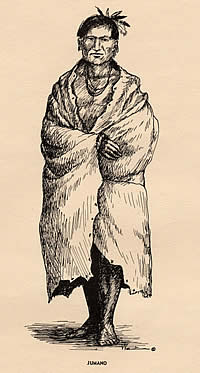Lands of the Jumano Indians
The Jumano Indians located their rancherías near large watercourses, including the Middle Concho River in this area and eastward. There they lived in encampments of grass huts, hunted deer and buffalo, fished, and gathered nuts. Some Jumanos served as interpreters, guides, and informers for the Spanish, accompanying expeditions into Texas. They formed extensive alliances and trade relations with other native groups, numbering as many as 36 during the 1683-1684 period alone. Such coalitions were formed for a number of reasons, chief among which was to form a united front against the warlike Apache. Increasingly, as those efforts proved insufficient, the native groups sought the help of the Spanish for protection.
Jumano leader Don Juan Sabeata, on behalf of his group and 12 other Jumano nations, implored the Spanish to travel to their lands on the Concho River, establish settlements, and help them against the warlike intruders. Toward that end, the Mendoza-Lopez expedition was dispatched in 1683, with Sabeata as a guide, and accompanied by Jumanos and members of other nations.
On February 1, 1684, the 49th day of their journey, the expedition reached the river, and the outskirts of Jumano territory. According to the expedition diary, the site was very pleasant and had abundant pastures, timber, and fish. The party established camp, placed a cross in the ground, and celebrated mass. They also caught and ate catfish from the river. The next day, they celebrated the feast of the Virgin of Candelaria before moving on to the east.
![]()
